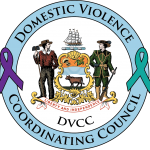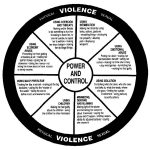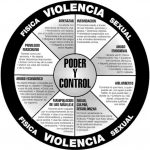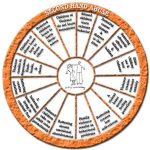Dating Violence | Immigration | State of DE – Domestic Violence Policy 
A. Definition and Scope of Problem
Domestic Violence is any abusive act between family members, ex-spouses, intimate cohabitants, former intimate cohabitants, dating couples and former dating couples in which one party seeks to gain/maintain power and control over the other partner. Couples or former couples can be of the same or opposite sex.
Domestic violence can be physical, sexual, emotional, economic, or psychological actions or threats of actions that influence another person. This includes any behaviors that intimidate, manipulate, humiliate, isolate, frighten, terrorize, coerce, threaten, blame, hurt, injure, or wound someone.
Two Categories of Domestic Violence
Domestic Violence consists of “Intimate Partner Violence,” which includes current and former spouses, current and former dating couples with or without a child in common and dating couples. This type of violence can occur among heterosexual or same-sex couples and does not require sexual intimacy. IPV can vary in frequency and severity. It occurs on a continuum, ranging from one hit that may or may not impact the victim to chronic, severe battering.
Domestic Violence also includes “Non-Intimate Partner Violence,” which is violence between individuals who are not intimate partners, but have a familial relationship, such as, mother/adult son, or brother/sister.
Domestic violence not only affects those who are abused, but also has a substantial effect on family members, friends, co-workers, other witnesses, and the community at large. Children, who grow up witnessing domestic violence, are among those seriously affected by this crime. Frequent exposure to violence in the home not only predisposes children to numerous social and physical problems, but also teaches them that violence is a normal way of life – therefore, increasing their risk of becoming society’s next generation of victims and abusers.
Why does domestic violence occur?
Violent and abusive behavior in relationships results from a complex mix of learned behavior, cultural values and historical precedent
- Witnessing violence between one’s parents or caretakers is the strongest risk factor of transmitting violent behavior from one generation to the next.
- Media portrayals of relationships are often violent and highly sexualized. Conflicts between partners are characterized by verbal and physical aggression. The level of generalized violence in the media including movies, television shows and video games contributes to a culture that accepts violence as a means of expression.
- It is important to note that domestic violence is not caused by the victims’ behavior, the use of alcohol or drugs, stress or mental illness.
- Those who abuse make a choice to engage in abusive behavior because they can – and because it works to get what they want.
Characteristics of victims and perpetrators
Who Are the Victims?
Victims of domestic violence can belong to any socioeconomic, ethnic or racial group.
- Old and young, female and male, gay and straight.
- Abuse may affect their ability to get or keep a job, maintain contact with friends and family, and develop connections within their communities.
- Domestic violence may have long term effects on a person’s physical and emotional well being.
Who Are the Perpetrators?
Perpetrators also belong to any socioeconomic, ethnic or racial group.
- Old and young, female and male, gay and straight.
- They may have been abused as children or witnessed a parent or other family member being abused.
- Exhibit a pattern of jealous and controlling behavior that isolates, threatens, and frightens their partner.
- May see their partner as central to their existence.
- Can be violent only within the abusive relationship.
B. Power and Control Techniques
Physical violence is the most typical form of abuse associated with domestic violence. However, victims suffer many types of abuse at the hands of their partners. Sexual coercion and assault are frequently part of the dynamics of a violent relationship. In addition, the power and control tactics described below reflect the common experiences of many victims of relationship violence. These tactics are used by perpetrators of domestic violence to maintain power and control over their partners.
This Power & Control Wheel (below) shows the kinds of behavior perpetrators use to gain and maintain control over their victim. Domestic violence abuse is never an accident. It is an intentional act used to gain control over the other person. Physical abuse is only one part of a whole series of behaviors an abuser uses against his/her victim. Violence is never an isolated behavior. There are other forms of abuse, which are shown in the Power and Control Wheel.
Power and Control Wheel* 
Power & Control Wheel (Spanish)*
The majority of domestic violence victims experience some combination of the power and control tactics described below.
Economic Abuse
The perpetrator maintains tight control over the couple’s finances and oversees what money the victim may have or spend. The perpetrator may not allow the victim to work; may sabotage any efforts the victim makes to get or keep a job and may require that the victim relinquish all earnings to the abusive partner.
Coercion And Threats
The perpetrator may threaten to harm the victim, victim’s children, other family members or family pet. They may also force the victim to engage in acts against her/his will or threaten to turn the victim into the Immigration and Naturalization Service, the Internal Revenue service or some other government agency. Threats of suicide by the perpetrator are also very common.
Intimidation
The perpetrator may try to intimidate the victim. This intimidation may occur through menacing looks or expressions, destroying property in front of the victim or by hurting or killing the family pets. Also, the perpetrator may display weapons in front of the victim as a means of frightening her or him.
Emotional Abuse
The perpetrator may use emotional abuse to convince the victim that they are crazy or irrational, thus causing them to doubt their own beliefs, experiences or feelings. This emotional abuse, in the form of name calling, constant criticism and insults, is much more serious than the occasional argument. To the contrary, the perpetrator often continually humiliates and degrades her/his partner, thus wearing away at the victim’s self-esteem.
Isolation
The perpetrator often tries to isolate the victim from friends and family members. The victim may not be allowed to leave home without permission and may be forbidden from making telephone calls. Eventually, the victim can become completely cut off from anyone who might be able to help her/him escape from the abuse.
Minimizing, Denying, Blaming
The perpetrator is likely to minimize or even deny their actions even in cases where injury occurs. If the police were called, but did not make an arrest, the perpetrator may rely on their inaction to deny wrongdoing. Also, the abusive partner will often blame the victim for their violent behavior and all too often, the victim will accept at least some responsibility for the abuse perpetrated upon them.
Using Children
Perpetrators may use the children to maintain control over the victim of the abuse. The perpetrator may threaten to harm the children or to kidnap them and flee the jurisdiction. Also, the perpetrator may tell the victim that if they leave, they will have abandoned the children and will lose custody forever. The victim can also be made to feel guilty for breaking up the family if she/he leaves the situation.
Using Male Privilege
Perpetrators may treat the victim like a servant, making all the important decisions, acting like the “master of the castle”, being the one to define men’s and women’s roles.
C. Cycle of Violence
The Cycle of Violence was first described by Lenore Walker in her 1979 work, The Battered Woman. This model can be useful when trying to understand the complex dynamics that occur in violent or abusive relationships. The Cycle of Violence has been described has having three stages: the tension building stage; the violent episode; and the honeymoon stage. Each stage is defined by certain characteristics. During the tension building phase, the relationship is typified by increasing hostility and stress that may be accompanied by frequent arguments and perhaps limited violence. This stage may eventually escalate to a more serious incident of violent and/or abusive behavior. It is during this second phase that injury is most likely to occur. It is also at this time that the victim in an abusive relationship may seek some type of intervention or assistance. The violent episode is frequently followed by a third phase, often referred to as the honeymoon phase. This phase is characterized by remorse on the part of the perpetrator and hope for change on the part of the victim.
Although not all abusive relationships follow this cyclical pattern, the cycle of violence can help to explain what both the victim and the abusive partner are experiencing in many instances. The victim of abuse may be more interested in stopping the violence than in ending the relationship, while the perpetrator may be afraid his/her partner will want to leave. The honeymoon phase represents their efforts to repair and normalize the relationship and may provide the victim with hope that the batterer’s behavior will change. In addition, the difficulties involved in ending a violent relationship may seem overwhelming for the victim of domestic violence. Unfortunately, in many abusive relationships the violence will continue and may escalate over time without intervention.

Cycle of Violence
D. Why victims stay in abusive relationships
A frequently asked question regarding victims in abusive relationships is “why don’t they just leave?” While it seems a simple enough way to end the abuse, the reality is that leaving a violent/abusive relationship is anything but simple.
Leaving an abusive relationship does not guarantee an end to the abuse; rather, the abuse often escalates at the time of separation. The most dangerous time for a victim can be when he/she attempts to leave or end the abusive relationship. Many domestic violence murder-suicides occur when the victim tries to end the relationship. Increased threats to children and other family members. The fact that many victims do leave or seek help is truly remarkable in light of the many barriers they face.
- increased danger to victim and children
- ifear of retaliation by the abuser
- lack of awareness of services
- lack of financial resources
- fear of losing custody of the children
- fear of not being believed
- religious, family and societal pressures
- shame
- denial of seriousness of abuse
- belief that the abuser will change/hope for a continued relationship
- lack of support network
- cultural and ethnic/racial barriers
Despite the many obstacles faced by victims, people continue to ask “why don’t they just leave?” It is time for us to change the dialogue. Instead of placing the burden on the victim to get out of the abusive relationship, it is time that we shift the focus to the person responsible – the abusive partner. Instead of asking why the victims will not leave, it is time that we ask instead, “why do people abuse and why is it allowed to continue?”
E. Impact of cultural issues on victims of domestic violence
Cultural differences can add further barriers to victims attempting to end abusive relationships.
- Courts, social service agencies, law enforcement and advocacy programs often lack fulltime interpreters to assist non-English speaking victims in filing complaints or accessing services.
- Victims from diverse cultures must work with programs and services that are unfamiliar with their language or customs and may seem unresponsive to their needs.
- Undocumented immigrant victims may be afraid to involve law enforcement out of fear that contact with the criminal justice system could result in deportation for the victim and/or their family.
Victims should be informed that reporting to the police or requesting a PFA from the courts will not subject him/her to deportation or removal proceedings.
F. Effects on Children
Children of all ages can be deeply affected by domestic violence
- Children who witness domestic violence are more likely to be in an abusive relationship when they grow up – whether as the abuser or the abused; and often experience anxiety, depression, eating and sleeping disorders and developmental delays and behavior problems.
- Delaware law recognizes that a child can be a witness to an act of domestic violence by sound as well as sight, acknowledging that a child may have only heard the violent act from another room, but nonetheless be a witness who is emotionally impacted by it. 11 Del. C. 8 §1102(a)(4)
 Second Hand Abuse Wheel**
Second Hand Abuse Wheel**
Infants – may not develop the appropriate attachments to their caretakers who are crucial to their development and may suffer “failure to thrive”.
Preschool Children – may regress developmentally and suffer sleep disturbances including nightmares.
School age Children – develop behavioral problems including: depression, anxiety, violence toward peers and difficulty with authority. In some cases the anxiety level can be so high children are afraid to attend school for fear of what will happen to the abused parent or younger siblings when they are not home.
Adolescents – have increased risk for repeating abusive behavior patterns in their dating relationships.
They are also at increased risk for alcohol and drug abuse, criminal behavior and eventual entry into the criminal justice system.
Adolescents are at risk of academic failure, school drop-out, delinquency, and substance abuse. Some investigators have suggested that a history of family violence or abuse is the most significant difference between delinquent and non delinquent youth.
Children who witness domestic violence may have the following symptoms
- eating, sleeping disorders;
- mood related disorders such as depression, emotional neediness;
- over compliance, clinginess, withdrawal;
- aggressive acting out; destructive rages;
- detachment, avoidance, a fantasy family;
- somatic complaints;
- finger biting, restlessness, shaking, stuttering;
- school problems, and
- suicidal ideations.
* Used with permission from the Domestic Abuse Intervention Project, Duluth, Minnesota, January 2002.
** Document courtesy of Ms. Kristina Korobov, Sr. Attorney for the National Center for the Prosecution of Violence Against Women.
Taken from: Domestic Violence, Resource Manual for Healthcare Professionals (prepared by the Domestic Violence Coordinating Council), 2011










